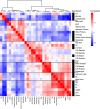Systemic alterations in the metabolome of diabetic NOD mice delineate increased oxidative stress accompanied by reduced inflammation and hypertriglyceremia
- PMID: 25852003
- PMCID: PMC4451288
- DOI: 10.1152/ajpendo.00019.2015
Systemic alterations in the metabolome of diabetic NOD mice delineate increased oxidative stress accompanied by reduced inflammation and hypertriglyceremia
Abstract
Nonobese diabetic (NOD) mice are a commonly used model of type 1 diabetes (T1D). However, not all animals will develop overt diabetes despite undergoing similar autoimmune insult. In this study, a comprehensive metabolomic approach, consisting of gas chromatography time-of-flight (GC-TOF) mass spectrometry (MS), ultra-high-performance liquid chromatography-accurate mass quadruple time-of-flight (UHPLC-qTOF) MS and targeted UHPLC-tandem mass spectrometry-based methodologies, was used to capture metabolic alterations in the metabolome and lipidome of plasma from NOD mice progressing or not progressing to T1D. Using this multi-platform approach, we identified >1,000 circulating lipids and metabolites in male and female progressor and nonprogressor animals (n = 71). Statistical and multivariate analyses were used to identify age- and sex-independent metabolic markers, which best differentiated metabolic profiles of progressors and nonprogressors. Key T1D-associated perturbations were related with 1) increases in oxidation products glucono-δ-lactone and galactonic acid and reductions in cysteine, methionine and threonic acid, suggesting increased oxidative stress; 2) reductions in circulating polyunsaturated fatty acids and lipid signaling mediators, most notably arachidonic acid (AA) and AA-derived eicosanoids, implying impaired states of systemic inflammation; 3) elevations in circulating triacylglyercides reflective of hypertriglyceridemia; and 4) reductions in major structural lipids, most notably lysophosphatidylcholines and phosphatidylcholines. Taken together, our results highlight the systemic perturbations that accompany a loss of glycemic control and development of overt T1D.
Keywords: diabetic mice; inflammation; metabolomics; oxidative stress.
Figures




References
-
- Abu-Lebdeh HS, Barazzoni R, Meek SE, Bigelow ML, Persson XM, Nair KS. Effects of insulin deprivation and treatment on homocysteine metabolism in people with type 1 diabetes. J Clin Endocrinol Metab 91: 3344–3348, 2006. - PubMed
-
- Baumann B, Salem HH, Boehm BO. Anti-inflammatory therapy in type 1 diabetes. Curr Diabet Reports 12: 499–509, 2012. - PubMed
-
- Benjamini Y, Hochberg Y. Controlling the false discovery rate: a practical and powerful approach to multiple testing. J Royal Stat Soc B (Methodological) 289–300, 1995.
-
- Bolton EE, Wang Y, Thiessen PA, Bryant SH. PubChem: integrated platform of small molecules and biological activities. Ann Rep Comput Chem 4: 217–241, 2008.
Publication types
MeSH terms
Grants and funding
LinkOut - more resources
Full Text Sources
Other Literature Sources
Medical
Miscellaneous

